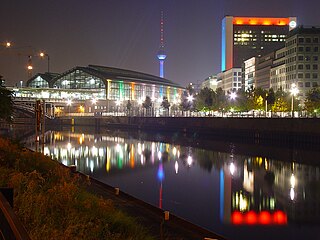
The Berlin S-Bahn is a rapid transit railway system in and around Berlin, the capital city of Germany. It has been in operation under this name since December 1930, having been previously called the special tariff area Berliner Stadt-, Ring- und Vorortbahnen. It complements the Berlin U-Bahn and is the link to many outer-Berlin areas, such as Berlin Brandenburg Airport. As such, the Berlin S-Bahn blends elements of a commuter rail service and a rapid transit system.
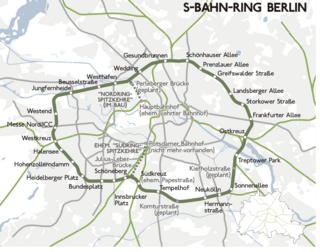
S41 and S42 operate a circular service on the Ringbahn and are part of the Berlin S-Bahn. The S41 operates clockwise around the circle, the S42 operates counter-clockwise.
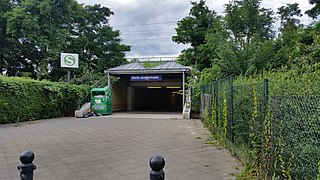
Berlin Jungfernheide is a railway station located at Charlottenburg-Nord, in the Charlottenburg-Wilmersdorf district of Berlin, served by the S-Bahn lines S41 and S42, the U-Bahn line U7 and Regional-Express trains of the Deutsche Bahn. Its name literally translates into "maidens' heathland"; it was named after the Jungfernheide, a former large forest in the proximity of this station.

U55 was an U-Bahn line in the German capital city of Berlin. It connected the new Berlin Hauptbahnhof, or main railway station, to an interchange with the S-Bahn at Brandenburger Tor. It had only three stations, did not connect to any other U-Bahn line, and was operated as a shuttle line using a single train.

The Hamburg S-Bahn is a suburban commuter railway network in the Hamburg Metropolitan Region. Together, the S-Bahn, the Hamburg U-Bahn, the AKN railway and the regional railway form the backbone of railway public transport in the city and the surrounding area. The network has operated since 1907 as a commuter rail system, under the direction of the state railway, and is a member of the Hamburger Verkehrsverbund. There are six lines, serving 68 stations, on 147 kilometres (91 mi) of route. On an average working day the S-Bahn transports about 590,000 passengers; in 2010 about 221 million people used the S-Bahn.
S26 is a line on the Berlin S-Bahn. It runs from Teltow in the district (Kreis) of Potsdam-Mittelmark via Südkreuz, through the Berlin Nord-Süd Tunnel with a stop at Friedrichstraße, and ends in Waidmannslust in the borough of Reinickendorf. On weekends the S26 runs from Teltow to Potsdamer Platz.

The Berlin S-Bahn line 47 (S47) runs from Spindlersfeld to Hermannstraße. It operates over:

The Berlin S-Bahn line 46 (S46) runs from Königs Wusterhausen to Westend. It operates over:

Berlin-Wedding is a station in the Wedding locality of Berlin and serves the S-Bahn lines S41 and S42 and the U-Bahn line U6.

Tempelhof is a railway station in the district of Berlin with the same name. It is served by the S-Bahn lines S41, S42, S45 and S46 and the U-Bahn line U6. The S-Bahn station is on an embankment at the junction of Tempelhofer Damm and Bundesautobahn 100, about 1 km south of the entrance to the former Tempelhof Airport. The U-Bahn station, officially called Tempelhof (Südring), is under Tempelhofer Damm immediately south of the S-Bahn station.

Berlin Hermannstraße is a railway station in the Neukölln district of Berlin. It is served by the S-Bahn lines S41, S42, S45, S46 and S47 and the U-Bahn line U8, of which it is the southern terminus. It was formerly also possible to transfer there to the Neukölln-Mittenwalde railway line, which is now only used for goods traffic.
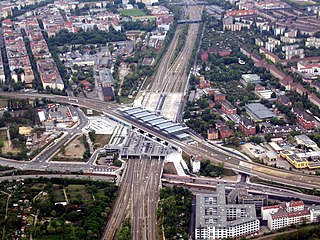
Berlin Südkreuz station is a railway station in the German capital Berlin. The station was originally opened in 1898 and is an interchange station. The Berlin Ringbahn line of the Berlin S-Bahn metro railway is situated on the upper level and connects to the east and west, whilst the Anhalter Bahn and Dresdner Bahn intercity railway routes reach the station on the lower, north-south level. The station was extensively rebuilt between the late 1990s and 2006, and was renamed Berlin Südkreuz on 28 May 2006.

The Ringbahn is a 37.5 km (23.3 mi) long circle route around Berlin's inner city area, on the Berlin S-Bahn network. Its course is made up of a pair of tracks used by S-Bahn trains and another parallel pair of tracks used by various regional, long distance and freight trains. The S-Bahn lines S41 and S42 provide a closed-loop continuous service without termini. Lines S45, S46 and S47 use a section of the southern and western ring, while lines S8 and S85 use sections of the eastern ring. The combined number of passengers is about 400,000 passengers a day. Due to its distinctive shape, the line is often referred to as the Hundekopf.

Berlin Gesundbrunnen station is a railway station in Berlin, Germany. It is situated in the Gesundbrunnen district, part of the central Mitte borough, as an interconnection point between the northern Ringbahn and Nord-Süd Tunnel lines of the Berlin S-Bahn, as well as a regional and long distance station of the Deutsche Bahn network. The station is operated by the DB Station&Service subsidiary of Deutsche Bahn AG and is classified as a Category 1 station, one of 21 in Germany and four in Berlin, the others being Berlin Hauptbahnhof, Berlin Südkreuz and Berlin Ostbahnhof.
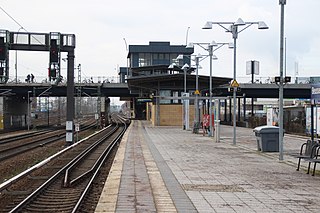
Beusselstraße is a Berlin S-Bahn station in the Moabit district in the Mitte borough of Berlin. It is located at the Beussel bridge, which carries the street of Beusselstrasse over the Berlin Ringbahn. It is served by the S-Bahn lines S41 and S42. It is additionally served by the line S46 on weekends.

Hohenzollerndamm is a station in the Wilmersdorf district of Berlin. It is served by the S-Bahn lines S41, S42 and S46. The station is located on the eponymous street named after the House of Hohenzollern. The neo-baroque entrance hall reminiscent of Art Nouveau design was erected in 1910.
The U11 line is a planned line of the Berlin U-Bahn.

The Berlin S-Bahn began on 8 August 1924 with the first section from Stettiner Vorortbahnhof to Bernau using steam locomotives. On 13 August 1961 it was broken up when the Berlin Wall was built, resulting in two sections: the eastern part and the western part. The western part experienced a massive strike which resulted in closure of several stations, after declining use. Attempts were made to reopen at various times but in the end, only three lines were finally opened after the strike. Since 9 November 1989, when the Berlin Wall was opened, the Berlin S-Bahn began to expand rapidly with their budgetary costs.

The BVG Class 480 is an electric multiple unit for the Berlin S-Bahn. It was originally meant to replace the aging S-Bahn rail cars in West Berlin, but after the reunification of the city, the remaining orders were cancelled and replaced by new orders for DBAG Class 481 cars in 1993.

The Heilbronn Stadtbahn is a three line tram-train system in city of Heilbronn in the German state of Baden-Württemberg. It is based on the Karlsruhe model and operated jointly by the Albtal-Verkehrs-Gesellschaft (AVG), the Stadtwerke Heilbronn (SWH) and Deutsche Bahn (DB). It operates on normal railways under the Eisenbahn-Bau- und Betriebsordnung and within Heilbronn under the Verordnung über den Bau und Betrieb der Straßenbahnen.


















